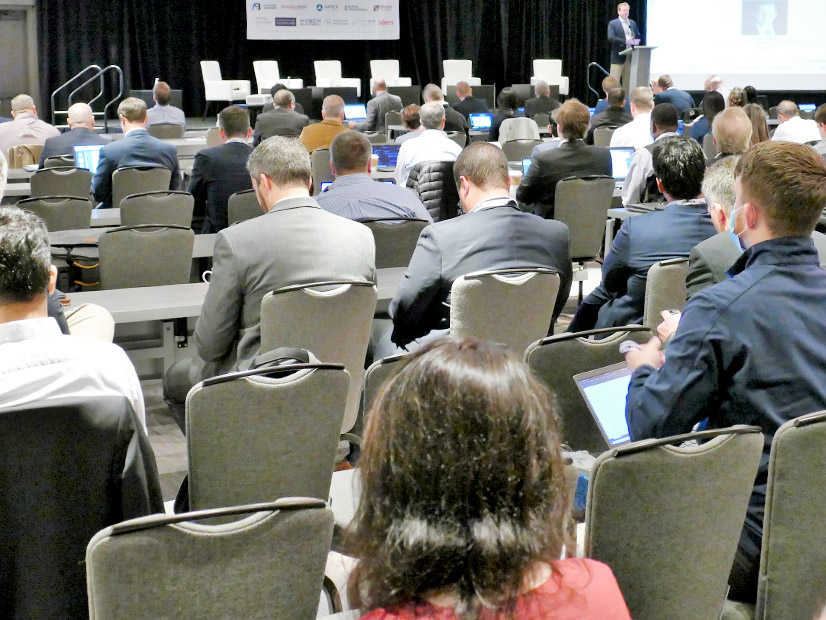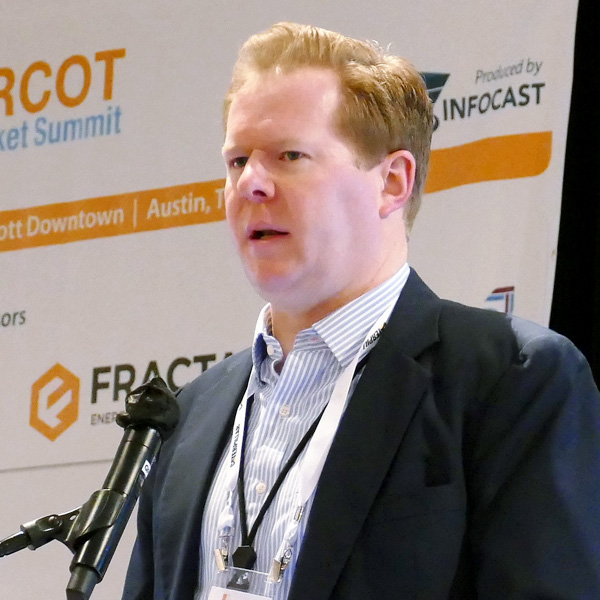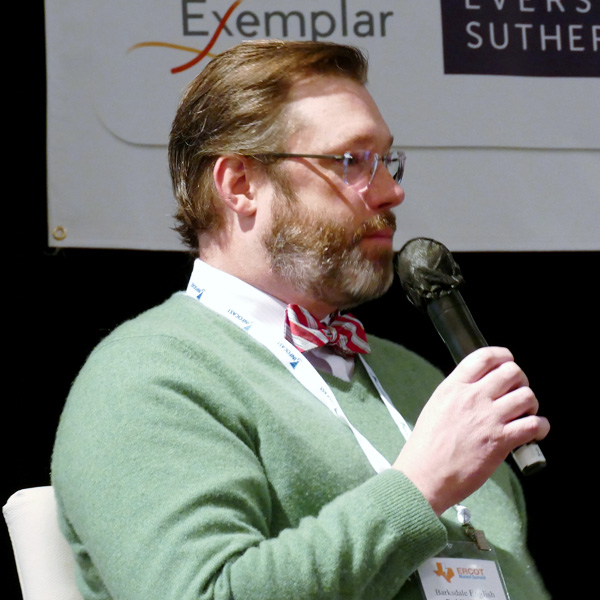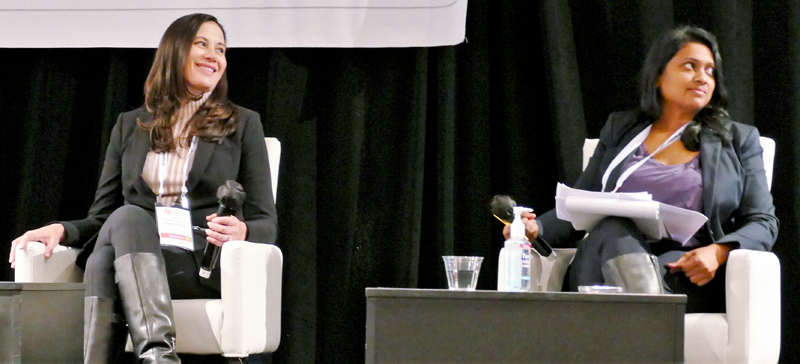
PUC’s Lake Clears up Market Redesign’s Ambiguity
AUSTIN, Texas — The state’s top electricity regulator, Public Utility Commission Chair Peter Lake, last week addressed the “ambiguity” over the second round of changes at ERCOT meant to address shortfalls in the grid’s performance during last February’s devastating winter storm.
Delivering the keynote address during Infocast’s ERCOT Market Summit on Feb. 23-25, Lake said the commission will develop two “products”: a load-serving entity reliability mechanism (LSERM) and a backstop reliability service (BRS).
“It’s not a contest; it’s not a debate. We did all that,” he said, referencing last year’s series of PUC workshops on market changes. “We will develop those products and build them out.”
 Texas PUC Chair Peter Lake | © RTO Insider LLC
Texas PUC Chair Peter Lake | © RTO Insider LLCWhen the PUC approved the two “Phase 2” mechanisms in December, it did so without addressing stakeholder comments it solicited on its strawman proposal. (See PUC Forges Ahead with ERCOT Market Redesign.)
However, Lake said the PUC will not accept any version of the proposals “sight unseen.” He promised “a lot” of stakeholder engagement “to ensure we get those right.” He promised to bring in consultants of the “highest caliber” to analyze the products’ different versions and help develop a “turnkey product” for ERCOT’s implementation.
“The commission is committed to adopting those proposals,” Lake said.
He said the LSE reliability product will capture the best features of five different similar mechanisms. LSEs would be subject to a formal reliability standard and be subject to penalties for nonperformance to ensure they have sufficient resources meet this standard.
“All put the obligation on the retail market, not the centralized administrative entity of ERCOT,” Lake said. “We believe the market is much better at procuring than a centralized governmental body. We will make it fungible, as easily integrated into the market as possible.
“We obviously want clear performance standards. We want forward pricing signals, for both investment and future generation of any kind and any form,” he said.
Lake brought up what he refers to as ERCOT’s “blue sky problem”: those normal 75-degree days when wind and solar drop off and put the grid in a “near crisis” condition.
“A lot of that is due to the intermittency of our renewable fleet,” he said. “We’ve been very deliberate as a commission to say we’re going to address the strength and drawbacks, pros and cons, of each resource. One of [renewables’] drawbacks is they’re not dispatchable. You can’t turn them on on-demand.
“Those two problems, the blue-sky problem and extreme weather problem, that’s what we’ve been addressing in the market design.”
Market Participants Respond to Lake
Lake’s failure to include wind and solar resources among the PUC’s dispatchable desired generation types, which also included hydrogen and geothermal, did not go unnoticed by some attendees.
Speaking on the panel following the chairman’s comments, Erika Bierschbach, Austin Energy’s vice president of energy market operations and resource planning, asked, “Do you want to incentivize future technology or some of those from the past?
“Some of those things out there … are just keeping things on support,” she said.
Fellow panelist Resmi Surendran, with Shell Energy, put in a plug for energy storage.
Austin Energy’s Erika Bierschbach (left), Shell’s Resmi Surendran during their panel discussion. | © RTO Insider LLC
“ERCOT should say what is the quality and the quantity of the megawatts that are needed, and anyone who wants to provide them, can provide them,” she said. “Batteries can provide a lot of functions.”
Vistra’s Ned Bonskowski, senior director of Texas regulatory policy, addressed Lake’s move away from the ERCOT market’s previous “crisis-based” model, where prices jumped during supply-scarcity conditions.
The grid operator’s conservative operations approach to managing the system by securing up to 8 GW of reserves at times has effectively dampened prices. Bonskowski said prices have largely stayed below $75/MW until an approaching cold front last week resulted in prices briefly hitting $4,000/MWh at one point.
“A very conservative operating theory … means more reserves are sitting there, which is more supply for relatively the same amount of demand. That tends to push prices down and you end up with a soft cap at $75,” Bonskowksi said. ”We’re in a period right now that’s pretty perilous from a market redesign standpoint. We got that little beacon of light this morning from what the market design ought to look like. Market participants had said they would like to see that sooner, but we understand this needs to be a robust process.”
A New ‘Policeman of Electricity’
Barksdale English, who directs the PUC’s Division of Compliance and Enforcement, said there is a new sheriff in town when it comes to enforcing the commission’s rules on weatherization, one of the key changes that came out of last winter’s storm.
“Or, as my daughter likes to say, I am the policeman of electricity,” he said.
 Barksdale English, Texas PUC | © RTO Insider LLC
Barksdale English, Texas PUC | © RTO Insider LLCNew rules required generators and transmission providers to file winter readiness reports by Dec. 1 for each of their units and their facilities, respectively. Eight companies failed to meet the deadline, with PUC staff recommending $7.68 million in administrative fees. (See “PUC Docks 8 Generators,” Texas PUC Chair Lake: ‘The Lights Will Stay On’.)
“The [state] legislature made it abundantly clear that they wanted, and their constituents wanted, their commission to take a different approach to the regulatory regime around preparing resources and facilities for extreme weather. One of the ways they signaled that was by changing rules around maximum penalties,” English said.
“The commissioners, when they discussed it, made it abundantly clear that: a) they expect their staff to use the full range of that penalty authority to signal to the rest of the industry and citizens of Texas that we took that mandate from the legislature pretty seriously, and b) to use it as a stick to get folks to do their best to get in compliance with the rule,” he said.
An audience member asked English why one 4.4-MW resource was assessed a $1.1 million penalty.
“If I allow one person with 4 MW to be out of compliance, I’ll have a bunch,” he said. “We have to treat everyone fairly and treat it seriously. If I don’t take that outage seriously, how can I take the next one seriously?”



